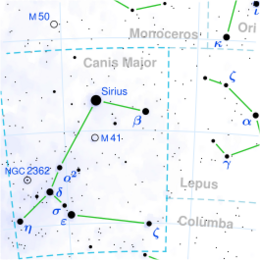Astronomy:HD 56405
| Observation data Equinox J2000.0]] (ICRS) | |
|---|---|
| Constellation | Canis Major |
| Right ascension | 07h 16m 14.55342s[1] |
| Declination | −15° 35′ 08.4724″ |
| Apparent magnitude (V) | 5.45[2] |
| Characteristics | |
| Spectral type | A1V[3] |
| B−V color index | 0.079±0.005[4] |
| Astrometry | |
| Radial velocity (Rv) | +6.30±0.9[5] km/s |
| Proper motion (μ) | RA: -46.118[1] mas/yr Dec.: -15.488[1] mas/yr |
| Parallax (π) | 13.1152 ± 0.1293[1] mas |
| Distance | 249 ± 2 ly (76.2 ± 0.8 pc) |
| Absolute magnitude (MV) | 0.88[4] |
| Details | |
| Mass | 2.13[6] M☉ |
| Luminosity | 38.86[4] L☉ |
| Surface gravity (log g) | 4.14±0.14[6] cgs |
| Temperature | 9,562±325[6] K |
| Rotational velocity (v sin i) | 149[6] km/s |
| Age | 212[6] Myr |
| Other designations | |
| Database references | |
| SIMBAD | data |
HD 56405 is a star in the southern constellation of Canis Major. It is white in hue and is dimly visible to the naked eye with an apparent visual magnitude of 5.45.[2] To the east of HD 56405 is the open cluster NGC 2360, also known as Caroline's Cluster.[8] The distance to HD 56405, as determined from parallax measurements, is approximately 249 light years. It is drifting further away with a radial velocity (RV) of about +6 km/s.[5] Although classed as a single star,[9] it is to suspected to vary in RV.[10]
This is an A-type main-sequence star with a stellar classification of A1V.[3] It was classed as a candidate Lambda Boötis star,[11] but as of 2015 this classification has been rejected by astronomers due to the star having an inconsistent UV flux, possible RV variability, and a fairly high rotation rate.[2] The star is about 212 million years old with 2.13 times the mass of the Sun and is spinning with a projected rotational velocity of 149 km/s.[6] It is radiating 39[4] times the luminosity of the Sun from its photosphere at an effective temperature of around 9,562 K.[6]
References
- ↑ 1.0 1.1 1.2 1.3 Brown, A. G. A. (August 2018). "Gaia Data Release 2: Summary of the contents and survey properties". Astronomy & Astrophysics 616: A1. doi:10.1051/0004-6361/201833051. Bibcode: 2018A&A...616A...1G. Gaia DR2 record for this source at VizieR.
- ↑ 2.0 2.1 2.2 Murphy, Simon J. et al. (October 2015). "An Evaluation of the Membership Probability of 212 λ Boo Stars. I. A Catalogue". Publications of the Astronomical Society of Australia 32: 43. doi:10.1017/pasa.2015.34. e036. Bibcode: 2015PASA...32...36M.
- ↑ 3.0 3.1 Houk, Nancy; Smith-Moore, M. (1978). Michigan catalogue of two-dimensional spectral types for the HD stars. 4. Ann Arbor: Dept. of Astronomy, University of Michigan. Bibcode: 1988mcts.book.....H.
- ↑ 4.0 4.1 4.2 4.3 Anderson, E.; Francis, Ch. (2012). "XHIP: An extended hipparcos compilation". Astronomy Letters 38 (5): 331. doi:10.1134/S1063773712050015. Bibcode: 2012AstL...38..331A.
- ↑ 5.0 5.1 Gontcharov, G. A. (2006). "Pulkovo Compilation of Radial Velocities for 35 495 Hipparcos stars in a common system". Astronomy Letters 32 (11): 759–771. doi:10.1134/S1063773706110065. Bibcode: 2006AstL...32..759G.
- ↑ 6.0 6.1 6.2 6.3 6.4 6.5 6.6 David, Trevor J.; Hillenbrand, Lynne A. (2015). "The Ages of Early-Type Stars: Strömgren Photometric Methods Calibrated, Validated, Tested, and Applied to Hosts and Prospective Hosts of Directly Imaged Exoplanets". The Astrophysical Journal 804 (2): 146. doi:10.1088/0004-637X/804/2/146. Bibcode: 2015ApJ...804..146D.
- ↑ "HD 56405". SIMBAD. Centre de données astronomiques de Strasbourg. http://simbad.u-strasbg.fr/simbad/sim-basic?Ident=HD+56405.
- ↑ Streicher, M. (December 2005). "Deepsky Delights: Caroline Herschel's deepsky discoveries". Monthly Notes of the Astronomical Society of Southern Africa 64 (11 and 12): 234–236. Bibcode: 2005MNSSA..64..234S.
- ↑ Eggleton, P. P.; Tokovinin, A. A. (September 2008). "A catalogue of multiplicity among bright stellar systems". Monthly Notices of the Royal Astronomical Society 389 (2): 869–879. doi:10.1111/j.1365-2966.2008.13596.x. Bibcode: 2008MNRAS.389..869E.
- ↑ Gerbaldi, M. et al. (December 2003). "The heterogeneous class of lambda Bootis stars". Astronomy and Astrophysics 412 (2): 447–464. doi:10.1051/0004-6361:20031472. Bibcode: 2003A&A...412..447G.
- ↑ Renson, P. et al. (December 1990). "Catalogue of Lambda Bootis Candidates". Bulletin d'Information du Centre de Données Stellaires 38: 137. Bibcode: 1990BICDS..38..137R.
 |


